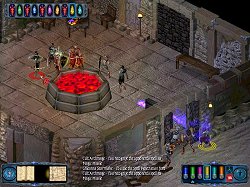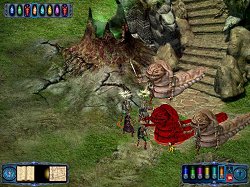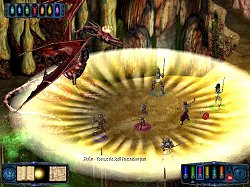|
Pool of Radiance: Ruins of Myth Drannor
 As the long awaited follow-up to the original Pool of Radiance, one of the much revered 'old school' roleplaying games based on the Pen and Paper Dungeons & Dragons games, this latest incarnation was always destined to run the gauntlet of comparisons. Since I haven't played the original I can't indulge in any reminiscing or in any comparisons. Neither can I comment on the stated implementation of the D&D 3rd Edition rules because that is not my area of expertise either. Hence I start this review with a clean slate and write it as a fantasy roleplaying fan rather than as a connoisseur of the Dungeons and Dragons phenomenon and the attendant rules.
So Pool of Radiance: Ruins of Myth Drannor escapes any potentially shaky comparisons from me, but it still got off to a shaky start entirely of its own volition. Unfortunately the first release late last year came complete with some serious bugs which I won't enumerate because I played the debugged version with hardly a hitch. And I played it with an nVidia Graphics Card that was apparently not the favourite card of the original release. Generally the game behaved well on my system, which has the recommended specs. The occasional slow-downs were the worst hurdles I faced and I learned to deal with them quickly or I'd be still playing the game right now. As the long awaited follow-up to the original Pool of Radiance, one of the much revered 'old school' roleplaying games based on the Pen and Paper Dungeons & Dragons games, this latest incarnation was always destined to run the gauntlet of comparisons. Since I haven't played the original I can't indulge in any reminiscing or in any comparisons. Neither can I comment on the stated implementation of the D&D 3rd Edition rules because that is not my area of expertise either. Hence I start this review with a clean slate and write it as a fantasy roleplaying fan rather than as a connoisseur of the Dungeons and Dragons phenomenon and the attendant rules.
So Pool of Radiance: Ruins of Myth Drannor escapes any potentially shaky comparisons from me, but it still got off to a shaky start entirely of its own volition. Unfortunately the first release late last year came complete with some serious bugs which I won't enumerate because I played the debugged version with hardly a hitch. And I played it with an nVidia Graphics Card that was apparently not the favourite card of the original release. Generally the game behaved well on my system, which has the recommended specs. The occasional slow-downs were the worst hurdles I faced and I learned to deal with them quickly or I'd be still playing the game right now.
On starting up the game you are treated to an introductory video in which you learn of a new Pool of Radiance that has awakened to spread evil throughout the land. The trusty Wizard Elminster engages you to look into the matter and you are transported to the fabled city of Myth Drannor to begin your quest.
You are then presented with a menu for choosing single or multi player mode, for accessing the game options (all self-explanatory) as well as for testing a short tutorial, which is the best place to start given the vagaries of the control system. I'd recommend paying attention to the tutorial although it won't totally prepare you for what is to come.
That out of the way, it's time to gather your party. You start out with four adventurers with the opportunity to pick up two more on your travels. Either you can choose your starting team entirely from the ready-made characters or you can create up to two characters of your own. Ruins of Myth Drannor has a simple character generation system. There are 6 races: human, elf, dwarf, halfling, half elf and half orc; and 8 occupations: fighter, ranger, barbarian, sorcerer, rogue, cleric, paladin and monk. Initially the game would not let me create a female in some of the occupations but a second installation remedied this problem for all but the monk class. For each individually created character you must also select a 'miniature', choose their alignment, distribute some ability scores and name them before entering the game.
 Pool of Radiance is a 3rd person perspective roleplaying game so you see your party on screen from above (and at a slight angle) and direct them in their deeds by using the mouse pointer. At the very bottom of the screen there is an icon to open your journal and the mapping feature. Also, each character has a coloured icon that indicates their health. By selecting an icon here you can take control of individual characters. Unlike other games such as Baldur's Gate or Icewind Dale, you cannot let your party get separated during exploration; they must stay together in a tight knit group. Safety in numbers I suppose, but this does limit (or prohibit) a party member scouting ahead too far to spy out danger. A right mouse click will display the statistics screen for each character and from here you can select a different member and study your party one by one, organise their inventories and weaponry and swap items between characters.
It is quite a long game so it's a long journey to your ultimate destination, fraught by many, many dangers in the form of scorpion-like Arraccats, snake-like Nargas, Lizardfolk, Orcs, Drow, and all manner of Undead. In fact the game is heavily focused on combat with very few friendly characters to interact with to divert you from your constant battles. After a couple of encounters at the beginning of the game where you meet a handy trader who'll give you a tip or two and Beriand the Sorcerer who starts you on the right track and gives you a much longer list of tips and quests, most everyone and everything else you meet is out to make mincemeat of you.
You begin your quest under the sparkling sun but very soon it's down into the dungeons for a lengthy excursion through four massive, maze-like halls where there are plenty of enemies to test, a good number of keys to find and treasures galore. Treasure hunting fanatics can indulge their passion without end, although I'm not sure that this wasn't overdone. If there's an awe-inspiring treasure in every chest they cease to feel like treasures and become a bit mundane.
After scouring the dungeons you do come up for air eventually and you also meet a few more characters that have information and quests for you to complete. It's not long though before it's back into the bowls of the earth to complete the game. Pool of Radiance is a 3rd person perspective roleplaying game so you see your party on screen from above (and at a slight angle) and direct them in their deeds by using the mouse pointer. At the very bottom of the screen there is an icon to open your journal and the mapping feature. Also, each character has a coloured icon that indicates their health. By selecting an icon here you can take control of individual characters. Unlike other games such as Baldur's Gate or Icewind Dale, you cannot let your party get separated during exploration; they must stay together in a tight knit group. Safety in numbers I suppose, but this does limit (or prohibit) a party member scouting ahead too far to spy out danger. A right mouse click will display the statistics screen for each character and from here you can select a different member and study your party one by one, organise their inventories and weaponry and swap items between characters.
It is quite a long game so it's a long journey to your ultimate destination, fraught by many, many dangers in the form of scorpion-like Arraccats, snake-like Nargas, Lizardfolk, Orcs, Drow, and all manner of Undead. In fact the game is heavily focused on combat with very few friendly characters to interact with to divert you from your constant battles. After a couple of encounters at the beginning of the game where you meet a handy trader who'll give you a tip or two and Beriand the Sorcerer who starts you on the right track and gives you a much longer list of tips and quests, most everyone and everything else you meet is out to make mincemeat of you.
You begin your quest under the sparkling sun but very soon it's down into the dungeons for a lengthy excursion through four massive, maze-like halls where there are plenty of enemies to test, a good number of keys to find and treasures galore. Treasure hunting fanatics can indulge their passion without end, although I'm not sure that this wasn't overdone. If there's an awe-inspiring treasure in every chest they cease to feel like treasures and become a bit mundane.
After scouring the dungeons you do come up for air eventually and you also meet a few more characters that have information and quests for you to complete. It's not long though before it's back into the bowls of the earth to complete the game.
 Since combat is such an important part of Pool of Radiance it ought to be simple and streamlined. I wish I could say that this is the case, but it isn't. In fact combat is quite fiddly and takes a lot of getting used to. The trouble is that the system uses a drop down menu type interface. Right click to open a general character menu from where you can choose combat options, spells or weapons, then navigate this short list to open up the drop down menu of your choice which is a text list of items or spells. (You can cut out one step by using keyboard shortcuts.) So if you choose magic, all magic items in your inventory will appear ... if you carry too many items the list goes on forever, you might even have to select 'more' to get the next 'page'. If you are not equipped with the magic item you want then you have to complete this process twice, once to equip it and then to use it.
This isn't conducive to 'pressure' combat where you're trying to save your skin and at the same time sort through a 'catalogue' of items to find something suitable. It will certainly clip the wings of anyone else like me who is a hoarder and usually fills their inventory to the brim with goodies. I had to make a concerted effort not to in this game. It's especially daunting because the writing is quite small and it's easy to check the wrong item and have to repeat the selection process.
Of course, if you are performing these acrobatics with the time limit on your turn ticking away it's very possible that you'll make a mistake and fritter away your turn. Practice might make perfect and, maybe, using the keyboard shorcuts that you can program, it would be possible to fight with the 'timed' feature adjusted to your liking. I adjusted it alright, right down to 'off' and, much to my amazement, after floundering during my first courageous attempts, I got to quite enjoy the combat. Since combat is such an important part of Pool of Radiance it ought to be simple and streamlined. I wish I could say that this is the case, but it isn't. In fact combat is quite fiddly and takes a lot of getting used to. The trouble is that the system uses a drop down menu type interface. Right click to open a general character menu from where you can choose combat options, spells or weapons, then navigate this short list to open up the drop down menu of your choice which is a text list of items or spells. (You can cut out one step by using keyboard shortcuts.) So if you choose magic, all magic items in your inventory will appear ... if you carry too many items the list goes on forever, you might even have to select 'more' to get the next 'page'. If you are not equipped with the magic item you want then you have to complete this process twice, once to equip it and then to use it.
This isn't conducive to 'pressure' combat where you're trying to save your skin and at the same time sort through a 'catalogue' of items to find something suitable. It will certainly clip the wings of anyone else like me who is a hoarder and usually fills their inventory to the brim with goodies. I had to make a concerted effort not to in this game. It's especially daunting because the writing is quite small and it's easy to check the wrong item and have to repeat the selection process.
Of course, if you are performing these acrobatics with the time limit on your turn ticking away it's very possible that you'll make a mistake and fritter away your turn. Practice might make perfect and, maybe, using the keyboard shorcuts that you can program, it would be possible to fight with the 'timed' feature adjusted to your liking. I adjusted it alright, right down to 'off' and, much to my amazement, after floundering during my first courageous attempts, I got to quite enjoy the combat.
As I said earlier I played the debugged version of POR so I didn't have any of the installation or save game problems. I did have severe slow downs during some battles, but this was rare. It happened, maybe, four or five times, and I quickly learned that if I prepared in advance and didn't open any menus then it wasn't too bad.
Other than this I did find that occasionally during combat my characters developed a stubborn streak and wouldn't move to where I told them and, sometimes they'd take up their designated position via the most convoluted route possible so that they missed out on their turn (i.e. circle the battle when they needed only to take a step to the right). This was a bit frustrating but never devastating. If it was a disadvantage during combat then there was a mighty advantage that outweighed it time and time again. I haven't heard anyone else report this but my Sorcerer was near untouchable. Instead of being the most vulnerable party member in need of constant mollycoddling during combat, she was seemingly invisible. For some reason none of the hoards of enemies took the slightest notice of her. When advancing they deliberately walked around her and honed in on someone else.
Anything else? Well, I was also frustrated by the need to keep the party so compact. Opening doors and chests sometimes became a lesson in patience because my Rogue would be too far from the party to perform an action. So invite everyone closer and they obstruct the proceedings. Moving them away one by one (but not too far) became a regular occurrence.
A couple of other things. Firstly, there is no way to retreat from battle. This means that if you have a 'charmed' opponent you have to wait for the spell to wear off or simply kill them to end a fight. It isn't fun killing non-aggressive characters. And lastly, I faced some considerable confusion when I dropped off one member and picked up a new member. The last character in line, Emmeric the fighter, moved up one notch to make way and turned from orange to light blue whilst Faeril (the new member) took over Emeric's place and colour. I'm not sure how long they stayed that way but sometime later I noted I was mixing them up and healing the wrong person. Lo and behold, they'd changed places and colours and slipped back into line again.
Glancing back I can see I've had a few complaints about this game. It might seem that I didn't enjoy it but this isn't totally the case. Although I can see that the vagaries of the combat system will test some players, you will get used to it. Despite my grumbles some of the battles towards the end of the game are quite challenging and require a well thought out strategy to get through.
In fact this game improves with age. For instance, it gets more interesting and varied when you leave the first set of dungeons. This is when the story kicks in more prominently, and you meet a few extra characters who have information and quests for you. It becomes immediately more involving. Also there's a lot of diligent exploring to take care of, and the graphics are pretty good, if a bit repetitive in the dingy dungeons. Though I must say that these dark areas make the spell effects look quite spectacular. My Sorcerer well and truly earned her keep letting go with fireballs and sending streaks of lighting into the fray. Area spells work wonders in this game both visually and practically, and the game engine lets you take careful aim so you (or your friends) don't get hurt.
Copyright © Rosemary Young 2002.
All rights reserved.
System Requirements:
Win 95/98/ME
Pentium II 400 (Pentium III 500 or Equivalent recommended)
64MB RAM (128MB recommended)
505MB Hard disk space (845MB recommended)
8xCD ROM
32 MB video card such as Geforce 2, Voodoo 5 or ATI Radeon or better
Sound Blaster Live or Aureal Sound Card
mouse
Recommended for multiplayer:
Host - Pentium III 600MHz or AMD 600MHz or faster
Clients - Pentium III 500 or Equivalent
Broadband: DSL, Cable or Satellite connection
|
